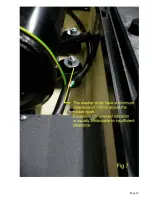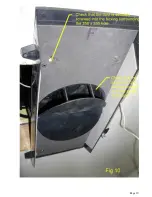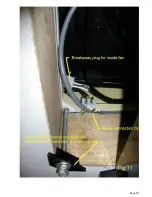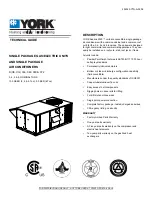
Page 5
Resistance to earth minimum 20 Meg
Ω
5: On cooling mode, compressor and outside fans stop.
Unit ceases to cool but display temp. drops to a low figure. Maybe
less than 10C.
This is typical of an inside coil icing up. The thermistor detects that the coil
is at or below zero and turns off the compressor until temp. rises to 12C,
Whereupon the compressor will restart.
This situation is usually associated with the unit running for a prolonged period
on low fan speed particularly in high humidity conditions.
This problem is usually overcome by running the unit on a higher speed and not
using ‘Auto” fan.
Check also that the return air filters are clean.
In heating mode, the unit stops heating, inside fan stops, and the red heat LED blinks.
This condition indicates that the unit has entered the de-ice mode to rid itself of frost on the
outside coils. The unit will restart automatically in 5 to 10 minutes.
It may be noted that the display temp drops to a low figure.
On resumption of heating, the blinking red light turns to a steady red, and the
inside fan start will be delayed until the inside coil is warmed to 32C. When the inside fan does
start there may be a momentary puff of vapour. This is normal.
7: In very cold conditions the compressor can be heard running but the inside fan does not start.
Be patient, in very cold conditions the unit needs time to warm sufficiently to start producing
warm air.
8: Compressor transmits excessive vibration.
Check that the top washer of the four compressor studs are clear of the rubber
Mount by 1 to 2 mm. Adjust if necessary. See fig 7
9: On heating, the unit cycles regularly, the temperature display indicates say 24 to 28C but the average
temperature in the van is very much less.
Disassemble the facia from the inside plenum (4 screws) and examine carefully
the extension duct for leaks, particularly where it joins the horizontal duct.
A leaking duct will short cycle warm air onto the return air sensor causing the compressor to
close down prematurely.
Repair any leaks and reassemble. (see Fig 10 and 24)
10: On cooling, the unit cycles regularly, the temperature display indicates say 22 to 25C but the
average temperature in the van is very much more.
Disassemble the facia from the inside plenum (4 screws) and examine carefully
the extension duct for leaks, particularly where it joins the horizontal duct.
A leaking duct will short cycle cold air onto the return air sensor causing the
compressor to close down prematurely.
Repair any leaks and reassemble. (see Fig 10 and 24)
11: Water drips from the inside plenum when the unit is in cooling mode.
Ingress of water on cooling mode may be due to either of four conditions.
1: The unit is installed more than 5
°
out of level, particularly nose down.
2: The drain holes in the evaporator area are blocked. See Fig 8
3: Condensation that has drained onto the roof, has re entered the installation hole either
under the roof seal of the airconditioner or a roof seam near the unit is faulty. If case 3
appears likely, the unit should be reinstalled using a new sealing gasket and following the
Aircommand instructions explicity.
If there is a roof seam involved, clean the seam area thoroughly and reseal
Summary of Contents for IBIS ROOFTOP CARAVAN
Page 12: ...Page 11 ...
Page 13: ...Page 12 ...
Page 14: ...Page 13 ...
Page 15: ...Page 14 ...
Page 16: ...Page 15 ...
Page 17: ...Page 16 ...
Page 18: ...Page 17 ...
Page 19: ...Page 18 ...
Page 20: ...Page 19 ...
Page 21: ...Page 20 ...
Page 22: ...Page 21 ...
Page 23: ...Page 22 ...
Page 24: ...Page 23 ...
Page 25: ...Page 24 ...
Page 26: ...Page 25 ...
Page 27: ...Page 26 ...
Page 28: ...Page 27 ...
Page 29: ...Page 28 ...
Page 30: ...Page 29 ...
Page 31: ...Page 30 ...
Page 32: ...Page 31 ...
Page 33: ...Page 32 ...
Page 34: ...Page 33 ...
Page 35: ...Page 34 ...
Page 36: ...Page 35 ...
Page 37: ...Page 36 ...
Page 38: ...Page 37 Diag 1 ...
Page 39: ...Page 38 ...







































